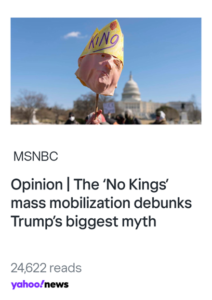
President Donald Trump has chosen to mark his birthday not with traditional festivities like cake or candles, but with a grand $45 million military parade in Washington, D.C. Officially, the event is framed as a celebration of the U.S. Army’s birthday, which coincidentally falls on the same day as Trump’s own. However, while the Army had long planned a celebration, a parade was never part of the original schedule until Trump’s administration intervened. On the very day the Army was created to oppose tyranny, the president is orchestrating a taxpayer-funded parade in his own honor.
This extravagant display of military power stands in stark contrast to the nonviolent ideals that have guided America’s freedom movements for decades. The essence of liberty and democracy is being overshadowed, and the event has drawn sharp criticism. “That’s not freedom. That’s not democracy. That’s not American,” say those opposing the spectacle.
In response, a nationwide movement called “No Kings” has emerged. On June 14, Americans across all states and territories, from large urban centers to rural towns, are preparing to stand up in protest. This mass mobilization declares a resounding message: America is a democracy, not a monarchy, and no one—including the president—should be treated like a king.
Critics argue that Trump is following a troubling and familiar pattern seen in authoritarian regimes around the world: centralizing power, suppressing dissent, targeting marginalized communities, amassing personal wealth, and diverting attention through displays of dominance. Since taking office, Trump has been accused of systematically weakening the foundations of democratic governance. His administration has launched attacks on the press and academic institutions, removed public servants deemed disloyal, and openly defied court rulings. Moreover, he has proposed deep cuts to public services and attempted to undo longstanding civil rights achievements.
His policies toward immigrants have drawn particular ire. His administration has targeted undocumented individuals in schools, places of worship, and workplaces. Critics say he has trampled due process and deported migrants to dangerous conditions abroad.
This parade, scheduled in the same week Trump deployed the National Guard and Marines to suppress protests in Los Angeles, has further inflamed tensions. These protests were themselves a response to what demonstrators describe as the president’s relentless attacks on immigrant communities and civil liberties. “We hold a parade of the people,” say organizers of the counter-movement, asserting their right to resist.
Trump’s power, they argue, doesn’t just stem from his office—it thrives on a myth of invincibility, the illusion that he can act with impunity. “That he can say and do whatever he wants, and no one can stop him,” is how his critics describe this myth. But they are quick to point out that this narrative only survives if it’s allowed to. “Authoritarianism feeds on fear and silence. It survives when institutions go along, and when people give up.”
Unfortunately, many elected officials, business leaders, and civil society institutions have either remained silent or acquiesced. But millions of Americans have not. From the moment Trump was sworn into office, waves of protests have erupted across the nation. These rallies have called out what demonstrators see as his anti-democratic actions, his attempts to reshape historical narratives, and his efforts to dismantle social safety nets.
As his second term progresses, public disapproval has grown. “The more people have seen of Trump’s lawless second term, the less popular he has become,” say activists. And now, on this Saturday, more than 1,500 protests are planned throughout the United States—from Washington to Florida, California to Maine. These demonstrations represent a powerful act of sustained resistance, rooted in a long tradition of civil disobedience and moral protest.
Marchers say they are inspired by the legacy of Dr. Martin Luther King Jr., whose belief in nonviolent resistance continues to guide many justice movements today. “Justice is not inevitable, it takes a movement,” say those organizing these marches. They emphasize that their protest is about more than opposing the parade—it’s about affirming the core principles of democracy. They want to remind the nation that “power belongs to the people, that democracy is worth defending, that we still believe in a government of, by, and for the people.”
This moment of mobilization is not just reactive but aspirational. It serves as a reminder of Dr. King’s vision for a fair and inclusive society. As the movement declares, it is “a dream toward which we have dedicated our lives’ and urge everyone to stand together in the face of this latest challenge to our fragile democracy.”
The psychological weight of authoritarian rule can make it seem permanent, but history has shown that such moments eventually break. “They crack when people speak. They crumble when people act. And they collapse when courage becomes contagious,” say the protestors. Trump, they argue, is relying on public fear and fatigue. But they are betting on collective courage and unity.
As one of the slogans of the movement declares: “Trump wants a crown, but we won’t bow. We will rise.”
This protest movement, driven by people from all walks of life, represents not just a rejection of Trump’s military parade, but a broader stand for the democratic values enshrined in the American Constitution. It’s a call to action, a refusal to accept silence, and a reaffirmation that in America, no one rules above the people.
